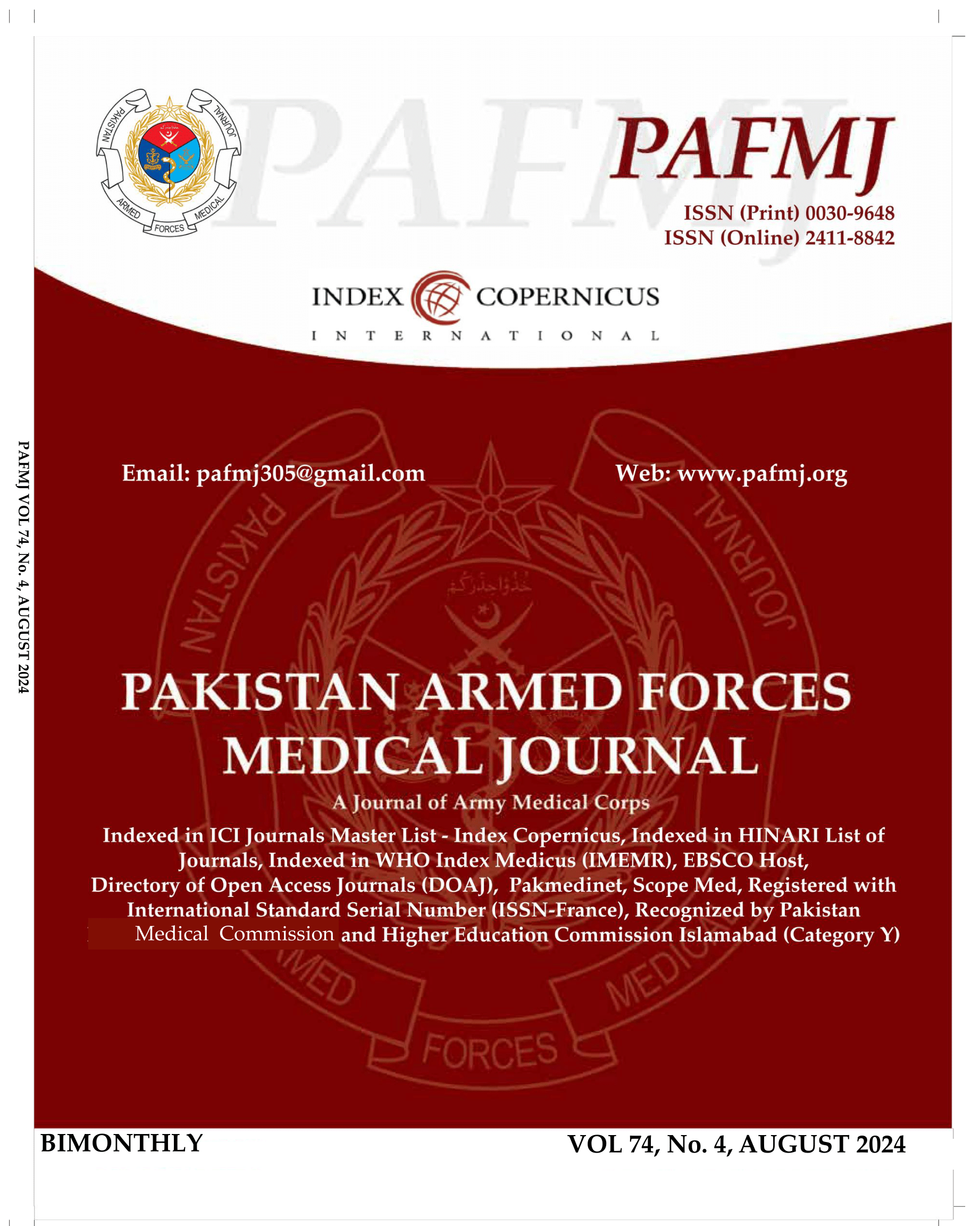Efficacy of Intravenous Magnesium Sulphate in Attenuating Hemodynamic Response in Hypertensive Patients to Laryngoscopy and Endotracheal Intubation
DOI:
https://doi.org/10.51253/pafmj.v74i4.6328Keywords:
Hemodynamic responses, Magnesium sulphate, Tracheal intubationAbstract
Objective: To determine the efficacy of intravenous Magnesium Sulphate in attenuating the hemodynamic response, Systolic Blood Pressure, in hypertensive patients undergoing laryngoscopy and endotracheal intubation compared with a Control Group.
Study Design: Quasi-experimental study.
Place and Duration of Study: Anesthesia Department, Pak Emirates Military Hospital, Rawalpindi Pakistan, from Apr to Oct 2018.
Methodology: A total of 110 diagnosed patients of hypertension, taking anti-hypertensive medication, between 30–65 years of age, belonging to either gender, and undergoing elective surgery were enrolled. Patients were given intravenous Magnesium Sulphate (30 mg/kg) in 20 ml normal saline over a period of 03 minutes before induction of general anesthesia while control Group was given 20 ml of normal saline (placebo). Systolic Blood Pressure for both Groups was recorded on a performa by an observer two minutes after intubation.
Results: The mean age of patients in treatment Group was 43.95±8.39 years and in control Group, 43.84±8.36 years. Out of 110 patients, 41(37.27%) were males and 69(62.73%) were females. The efficacy of MgSO4 was 16(29.09%) and in control Group, it was 04(7.27%) with p-value of 0.003(<0.05).
Conclusion: Intravenous Magnesium Sulphate is efficacious in attenuating hemodynamic response to laryngoscopy and intubation in hypertensive patients.
Downloads
References
Moradifar M, Faramarzi R, et al. Effects of intravenous administration of fentanyl and lidocaine on hemodynamic responses following endotracheal intubation. Am J Emerg Med 2018; 36(2): 197-201 https://doi.org/10.1016/j.ajem.2017.07.069
Megalla SA, Abdou KA, Mohamed AI. Bispectral index guided attenuation of hemodynamic and arousal response to endotracheal intubation using magnesium sulfate and fentanyl. Randomized, controlled trial. Egypt J Anaesth 2019; 35(1): 43-48. https://doi.org/10.1080/11101849.2019.1595346
Mostafa MF, Herdan R, Fathy GM, Hassan Z, Galal H, Talaat A, et al. Intrathecal dexmedetomidine versus magnesium sulphate for postoperative analgesia and stress response after caesarean delivery; randomized controlled double-blind study. Eur J Pain 2020; 24(1): 182-191. https://doi.org/10.1002/ejp.1476
Mendonca FT, de Queiroz LM, Guimaraes CC, Xavier AC. Effects of lidocaine and magnesium sulphate in attenuating hemodynamic response to tracheal intubation: singlecenter, prospective, double-blind, randomized study. Rev Bras Anestesiol 2016; 67(1): 50-56.
https://doi.org/10.1016/j.bjan.2016.02.001
Buhari FS, Selvaraj V. Randomized controlled study comparing the hemodynamic response to laryngoscopy and endotracheal intubation with McCoy, Macintosh, and C-MAC laryngoscopes in adult patients. J Anaesthesiol Clin Pharmacol 2016; 32(4): 505. https://doi.org/10.4103/0970-9185.194766
Panda NB, Bharti N, Prasad S. Minimal effective dose of magnesium sulphate for attenuation of intubation response in hypertensive patients. J Clin Anesth 2013; 25(2): 92-97.
https://doi.org/10.1016/j.jclinane.2012.06.016
Rodriguez-Rubio L, Nava E, Del Pozo JSG, Jordan J. Influence of the perioperative administration of magnesium sulphate on the total dose of anesthetics during general anaesthesia. J Clin Anesth 2017; 39: 129-138.
https://doi.org/10.1016/j.jclinane.2017.03.038
Vickovic S, Pjevic M, Uvelin A, Pap D, Nikolic D, Lalic I. Magnesium sulphate as an adjuvant to anesthesia in patients with arterial hypertension. Acta Clin Croat 2016; 55(3): 490-496. https://doi.org/10.20471/acc.2016.55.03.20
Sawan ZH, Abaza KA, Zyada A, Ezz El-Din A. Magnesium Sulfate Versus Lidocaine for Attenuating Hemodynamic
Response to Tracheal Intubation. Egypt J Hosp Med 2020; 81(7): 2433-2438. https://doi.org/10.21608/ejhm.2020.133954
Gnanapragasam R, Gomaa A, Patil V. Evaluation of the efficacy of lidocaine and magnesium sulphate in reducing the hemodynamic effects caused after intubation/laryngoscopy. Braz J Anesthesiol 2019; 68(2): 212.
https://doi.org/10.1016/j.bjane.2017.08.0010104-0014/
Kotwani MB, Kotwani DM, Laheri V. A comparative study of two doses of magnesium sulphate in attenuating hemodynamic responses to laryngoscopy and intubation. Int J Res Med Sci 2016; 4(7): 2548-2555.
http://dx.doi.org/10.18203/2320-6012.ijrms20161901
Barbosa FT. Effects of lidocaine and magnesium sulfate in attenuating hemodynamic response to orotracheal intubation: a single-center, prospective, double blind, randomized study. Rev Bras Anestesiol 2017; 67(6): 666.
https://doi.org/ 10.1016/j.bjan.2017.01.002
Cavalcanti IL, Lima FL, Silva MJ, Cruz Filho RA, Braga EL, Verçosa N. Use profile of magnesium sulfate in anesthesia in Brazil. Front pharmacol 2019; 10(1): 429.
https://doi.org/10.3389/fphar.2019.00429
James MFM, Beer RE, Esser JD. Intravenous magnesium sulfate inhibits catecholamine release associated with tracheal intubation. Anesth Analg 1989; 68(6): 772-776.
Puri GD, Marudhachalam KS, Chari P, Suri RK. The effect of magnesium sulphate on hemodynamics and its efficacy in attenuating the response to endotracheal intubation in patients with coronary artery disease. Anesth Analg 1998; 87(4): 808-811. https://doi.org/10.1097/00000539-199810000-00012
Padmawar S, Patil M. A comparative study of 2% lignocaine vs 50% magnesium sulphate for attenuation of stress responses to laryngoscopy and endotracheal intubation. Age 2016; 29(30.9): 1-5.
Abbady A. Treatment of stress response to laryngoscopy and intubation with magnesium sulphate. El-minia med Bull 2009; 20(2) 82.
18. Sharma J. Comparative study of Magnesium Sulfate and Esmolol in attenuating the pressor response to endotracheal intubation in controlled hypertensive patients. J Anaesth Clin Pharmacol 2006; 22(3): 255-259.
Downloads
Published
Issue
Section
License
Copyright (c) 2024 Muhammad Rashid Hanif, Syed Asadullah Jafri, Liaquat Ali, Sana Abbas, Usman Saqib, Usman Ahmed

This work is licensed under a Creative Commons Attribution-NonCommercial 4.0 International License.















